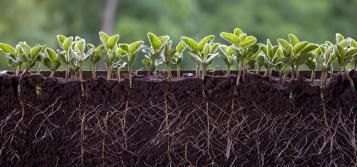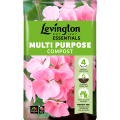
A beautiful garden starts with healthy soil. Improving your border soil by adding compost and following good gardening practices takes time, but it’s one of the most important things you can do for your garden and the results are well worth the effort!
What is soil made of?
Soil is made up of a mixture of organic materials, such as decomposing leaves, and inorganic materials, such as tiny particles of clay, sand and silt that come from the erosion of rocks. Healthy soils also contain a wide range of organisms from bacteria to earthworms that break down decomposing plant material and incorporate it into the soil.
Why we need to improve garden soil
In wild areas like woodland or meadows, soils are improved naturally by organic matter such as fallen leaves, plant material and even dead animals which decay and are reabsorbed into the soil. In gardens, we tend to clear away fallen leaves and old plants before they have a chance to break down, which is why we need to enrich our garden soil by regularly adding organic matter such as garden compost, farmyard manure, leaf mould or composted bark back into it. Soil conditions can differ widely between gardens, but all garden soils will benefit from improvement to keep them healthy from year to year.

How to tell what type of soil you have
Most soils are a mixture of clay, sand and silt, and behave differently depending on how much of each type of particle they contain.
A simple way to tell whether your soil is predominantly sandy, or clay is to use the ‘sausage test’. Dig up a trowelful of soil from around 30cm below the surface. Take a handful of the soil, add enough water to make it stick together, then try to roll it into a sausage shape between your palms. Very sandy soil will feel gritty and won’t hold together as a sausage. The more clay there is in the soil, the easier it will stick together and hold its shape. Loam soil can be rolled into a sausage, but this will crumble when touched. Very clay soil will roll easily into a thin sausage shape, and you should be able to smooth the surface to a shiny finish with your fingertip.
To check whether your soil is chalky, put a spoonful of soil into a glass of vinegar. If it froths, it’s chalk soil.

How to improve clay soil
Clay soils are wet and cold in winter but can bake hard in summer. They drain poorly and will compact quickly if walked on when wet. On the plus side, however, they are high in nutrients and retain these nutrients well even in heavy rains. To improve clay soils, dig in plenty of bulky organic material such as farmyard manure or composted bark in early autumn before the soil gets too heavy and wet in winter.
How to improve sandy soil
Sandy soils are light, free draining and warm. They are easy to dig, but they dry out quickly in summer and can be low in nutrients, which are washed out of the soil in heavy rains. To improve sandy soils, dig in organic material such as farmyard manure to help the soil retain moisture in dry periods, and add fertiliser to replace nutrients that have been washed out. Mulch annually with organic soil improver.
How to improve chalk soil
Chalk soils tend to be free-draining and low in nutrients. To improve chalk soil, regularly add plenty of garden compost, farmyard manure, leaf mould or other organic material as this breaks down quickly in chalky soils.
How to improve loam soil
Loam soils are what every gardener dreams of! Perfectly loamy soil is a mixture of sandy and clay soil that combines the best attributes of both types. In reality, most soils will be either a clay-loam or a sandy loam, and will also benefit from annual mulching with well-rotted garden compost, farmyard manure or other organic material.
How to improve border soil in 4 steps

Organic soil improvers can either be dug into the soil or spread in a thick layer on the surface of the soil in autumn as a mulch. Digging in soil improver can be hard work, but it’s well worth the effort. You don’t need to sieve garden compost when using it as a soil improver – any large clumps will gradually break down in the soil and can help improve drainage in heavy soils.
Digging in organic material is best done on new areas before planting, or on beds that have been cleared of plants, such as vegetable beds. If the soil has not been dug for a long time and is very compacted, it’s best to use a spade for this. For looser soils, you can use a garden fork.
- Choose a dry day when the soil is not frozen or waterlogged.
- Dig or fork the soil over to the depth of the spade blade or the fork tines, breaking up any compacted clods of earth. Remove any perennial weeds and large stones.
- Spread a 5cm thick layer of garden compost, farmyard manure or leaf mould over the soil and dig it in.
- Tread over the soil to level it, breaking up any remaining large clods of earth, then rake it smooth.
How to improve soil quality by mulching
Mulching with organic matter is a very effective soil improvement technique. It can be done any time between autumn and spring, provided the ground isn’t frozen. The best time to mulch is in autumn, as this gives worms and other soil organisms time to improve the soil over winter by working the mulch into it. As many plants die back in autumn, there’s also more space at this time of year to work around the remaining plants in the beds.
Late autumn mulching is a good way of improving soil for growing vegetables, as these beds are often cleared in by this time of year. However, if you don’t manage to get around to mulching in autumn, you can still do it in spring – just be careful not to tread on emerging plants! Don’t mulch frozen soil, as the mulch will act as insulation, keeping the soil frozen for longer.
- Before mulching, tackle weeds and remove any dead plants, and cut back any herbaceous perennials that have died back.
- Spread a layer of farmyard manure, compost or other organic material over the surface of the soil. The layer should be at least 5cm thick. If you don’t have enough mulch to cover all of your beds, it’s better to do a thick layer over a smaller area than spread it thinly over the whole garden.
- Leave a gap around the base of each plant so that the mulch doesn’t touch the stems or trunks, as this could cause rotting.
FAQs
How do you know whether your soil is poor quality?
The most obvious sign of poor soil is plants failing to thrive. Plants may look stunted and will produce fewer flowers and less fruit. Their leaves may be discoloured, indicating a lack of essential nutrients in the soil. Although people tend to blame themselves when their plants fail, the truth is that it’s often due to the quality of soil or compost used. The good news is that poor soils can be easily improved by adding organic soil improvers.
What’s the fastest way to improve soil quality?
Digging in organic matter like compost or well-rotted farmyard manure is one of the quickest ways to improve soil quality. Dig in plenty of organic matter to new beds before planting and spread a thick layer of organic mulch over beds in autumn or spring.
What’s the best soil mix for borders?
The best soil mix for most plants is loam, which is a mixture of sandy, silty and clay soil. If you’re not lucky enough to have perfect loam soil, you can improve your soil by digging in soil improver before planting and mulching annually with garden compost other organic material.








